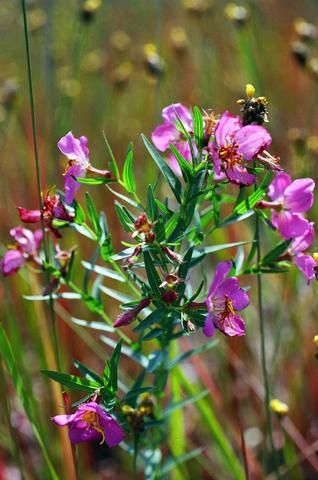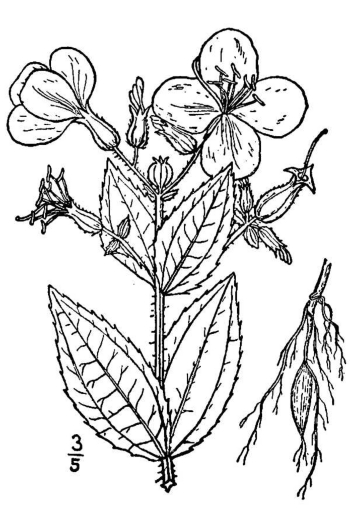Rhexia virginica
 |
 |
Photo Courtesy Renee Brecht |
Britton & Brown |
| Botanical name: | Rhexia virginica |
| Common name: | Virginia meadow-beauty or Handsome Harry |
| Group: | dicot |
| Family: | Melastomataceae |
| Growth type: | forb/herb |
| Duration: | perennial |
| Origin: | native |
| Plant height: | 1 - 2' |
| Foliage: | The stem is squared and slightly winged at the edges. The stem becomes fleshy and fibrous toward the base as an adaptation for absorbing oxygen from the water. Opposite leaves, with three prominent veins and small teeth along the margins. Leaves and stem are smooth but dotted with glandular hairs, which give the plant a bristly appearance. |
| Flower: | 1 to 1-1/2 inches across with 4 petals, magenta |
| Flowering time: | Flowers early July to mid-September. Fruits early August into autumn... Fruit is a distinctive seed capsule shaped like a small jug with four points |
| Habitat: | wet, sandy soil |
| Range in New Jersey: | Common in sandy swamps throughout the Coastal plain region and northward to Closter, Bergen County, and Stockton, Hunterdon County. Especially abundant in the Pine Barrens. (Stone 1911) |
| Heritage ranking, if any: | n/a |
| Distribution: |  |
| Misc. | USDA
lists as an obligate wetland species, i.e., Occurs almost always
(estimated probability 99%) under natural conditions in wetlands. Rhexia, From the Greek rhexio, (rupture); referring to the belief the plant had curative benefits for ruptures; virginica, of or from Virginia. Often occurs with other outer coastal plain species such as Rhynchospora capitellata, Twig-rush (Cladium mariscoides), Yellow-eyed-grass (Xyris difformis), Marsh St. John's-wort (Triadenum virginicum), Dichanthelium spretum, Golden Hedge Hyssop (Gratiola aurea), and horned bladderwort (Utricularia cornuta). Plants are cross-fertilized by nectar feeding insects such as honeybees and the common yellow sulfur butterfly (Colias philodice) Stone notes "throughout the latter part of the summer its gorgeous flowers are conspicuous, sometimes in scattered clumps or individual plants, and again massed in large patches, so that the whole surface of the bog seems crimson. There is a certain amount of variation in color, some flowers being very deep magenta, but they never approach the pale pink of R. mariana. Pollination Ecology of Rhexia virginica |